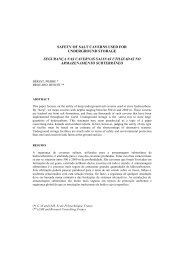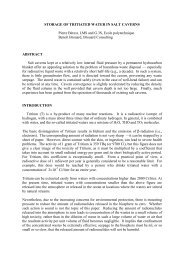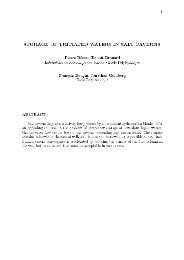SOLUTION MINING RESEARCH INSTITUTE - Brouard Consulting
SOLUTION MINING RESEARCH INSTITUTE - Brouard Consulting
SOLUTION MINING RESEARCH INSTITUTE - Brouard Consulting
You also want an ePaper? Increase the reach of your titles
YUMPU automatically turns print PDFs into web optimized ePapers that Google loves.
An example of such a test was described by Hugout (1988) for a cavern that was part of the Etrezsite (Ain, France), operated by Gaz de France. It was 950 m deep with a volume of8000 m 3 . Before the test, the central string was filled with saturated brine and the annular spacewas filled with a light hydrocarbon, A brine flow from the central string was observed. Whenhydrocarbon was vented, the pressure drop was 3 MPa and the air/brine interface in the centralstring dropped by several hundred of meters. The test measured the hydrocarbon outflow rate. Forseveral days, the hydrocarbon outflow rate was quite large due to the roles played by transientcreep and additional dissolution (Figure 3). After a couple of weeks, the hydrocarbon outflowrate became more or less constant (and much larger than the outflow rate should be in a brineoutflow test —clear evidence of the non-linear effect of cavity pressure on cavern closure rate.)When halmostatic pressure was restored on day 254 (The hydrocarbon-filled annulus was closedduring this last phase.), brine outflow from the central tubing was negative, strongly suggestingcavern volume transient increase, or “reverse” creep. A complete discussion of this test can befound in Van Sambeek et al. (2005).Figure 3Hydrocarbon Outflow Test: From day 93 to day 254, the cavern pressure waslowered below halmostatic, resulting in large transient hydrocarbon flow,followed by a more-or-less steady-state hydrocarbon flow. The hydrocarbonflow rate is larger than the brine flow rate before the pressure change on day 93or the brine flow rate after the initial pressure had been restored on day 254(Hugout, 1988).A similar test has been described by Clerc-Renaud and Dubois (1980) for a cavern belonging tothe Manosque site (South Eastern France), operated by Geostock. This cavern was 569- to 864-mdeep with a volume of 235,000 m 3 . The cavern was filled partly with oil (oil volume of 185,000m 3 ). The wellhead oil pressure was 550 psi before the test; the wellhead brine pressure was zero.The wellhead oil pressure was released (PQ on Figure 4) by opening a valve that isolated theannular space from the central string. Oil outflow was measured for 2000 hours (QR on Figure 4),after which brine was injected in the central tube to increase the wellhead oil pressure by 550 psi(RS on Figure 4). Brine outflow then was measured for 2000 hours (ST on Figure 4). Fastconvergence rates following a pressure decrease (phase QR) and “reverse” convergencefollowing a pressure increase (phase ST) were observed. This test is interpreted in more detail inSection 3.3.
where μ = E / 2(1+ν ), andσ = 3J2.In this paper, the following parameter values were selected:A( Q RT)−13 4exp − = 1.1×10 /MPa /day−10n = 4 , K 0= 1.2× 10 , c = 0.0315, m = 3α = 15, β = 0, δ = 0.58ww• BBK Transient Law — The Munson-Dawson law does not take into account“reverse” creep. This law was modified slightly to become the BBK TransientLaw, as follows:F = 1−( 1−ς/ ε ) /( 1 − k)* p ptwhen*ς > ε t; reverse creep appears whenς > kε, or F < 0.In this paper, the following parameter values were selected: p = 2.4, k = 1.1.*t• Lemaitre-Menzel-Schreiner Law — This constitutive law is used widely inFrance and can be described as follows: ε∂= ∂ t ∂ σα ∂( ζ ) ( 32 )vpijJij⎛ 3Jζ2⎞ = ⎜K ⎟⎝ ⎠In this paper, the following parameter values were selected: β = 3.3,α = 0.13, K = 1.5 MPa.The Manosque test was back-calculated. (Results are given on Figures 5 and 6.) Parameters ofthe three constitutive laws first were fitted against the as-observed oil outflow during the 2000-hour long QR phase (day 485 to day 585). These parameters were used to compute the ST phase,during which brine was injected into or withdrawn from the central tubing to keep the wellheadpressure as constant as possible. Two computations were made.1. The flow during the ST phase was predicted first, assuming that cavern pressure wasconstant during this phase. (See Figure 5; the effect of brine and oil thermal expansion,assessed before the test, has been subtracted.) The Lemaitre and Munson-Dawson Lawsgive similar results: the two curves are identical. They were not able to capture the effectof the pressure increase on day 585.βα
Figure 5. Three constitutive laws are fitted against as-observed oil flow during the days485 to 535 to predict brine flow during days 585 to 735. (The M-D and L-M-Scurves are identical.)Figure 6. The as-observed brine flow during the RT phase is fitted against variousconstitutive models to compute cavern pressure. (The M-D and L-M-S curvesare identical.)• In fact, the as-observed pressure was not perfectly constant during the ST phase. It wasdecided to back-calculate the pressure history that fit-best the as-observed brine flowhistory and to compare it with the as-observed pressure evolution (Figure 6). When usingthe BBK Law, an excellent fit can be found (except during the 10 first days, whentransient phenomena other than transient creep play a significant role; see Section 4.2).
P si /TVD = 0.0221 MPa/m. The depth dependence of tensile strength as a materialproperty is less significant with an average value of 6.3 MPa. (p.5)The authors conclude “The shut-in pressure profile [a measure for the minimum principal stress]is in good agreement with the vertical stress profile derived from various geophysical logs for theoverburden density. (p.1)”. This profile was “derived from the final refrac cycle to guaranteefractures had propagated away from the borehole and had adjusted to the far field stress”, acomment whose significance will appear later. Similar studies were presented by Schmidt (1993)and Staudtmeister and Schmidt (2000).5.3 The Effect of Stress Redistribution at the Borehole WellAs was pointed out first by Wawersik and Stone (1989), the state of stress in the vicinity of aborehole may be complex, making test interpretation more difficult. When a borehole is keptopen for a long time (say, several years), the brine pressure remains halmostatic, and stressredistribution, from the initial “elastic” distribution to the final “steady-state creep” distribution(as explained in Section 3) takes place slowly. In this process, the difference between radial andtangential stresses is made significantly smaller than it had been when the stress distribution was“elastic”. When pressure is increased rapidly in a well (as it is during a hydraulic fracturing test),the incremental stress increase is elastic, and the tangential stress becomes smaller than brinepressure before the brine pressure becomes geostatic, in sharp contrast with what happens duringa standard hydro-fracturing test in an elastic medium. In other words, fracturing pressure issignificantly smaller when a test is performed long after a borehole is opened.5.4. Steady-State BehaviorA simple analysis can be performed when a well was kept idle for a long period before hydrofracturingis performed. Assume that the brine pressure in the well was kept halmostatic duringthis period, P = P h . The period was long enough to reach mechanical steady-state, or2/σ ( )( / ) nrr=− P∞ + P∞− Pha r2/σ P ( P P)(1 2/ )( / ) nθθ=−∞+∞−h− n a rNow, pressure in the well is increased rapidly. The additional stresses generated by a pressureincrease of ( P−P ) can be computed using the elastic solution andh2/σ P ( P P)(1 2/ )( / ) nθθ ∞ ∞ hn a r=− + − − +( P−P)( a/ r)h2and fracturing will be reached at the borehole wall (r = a) when σ θθ + P > T, orP> P + T /2 −( P −P)(1−1/ n)∞That is, fracturing will occur when a pressure much smaller than that in the “elastic” case isreached. In fact, in some cases, fracturing will be reached when the pressure is smaller thangeostatic. For instance, assume, for simplicity, that the tensile strength is zero, T = 0, and theexponent of the Norton-Hoff power law is n = 4. In a 1000-m deep well, the geostatic pressure isP ∞= 22 MPa ( P h= 12 MPa), and one might expect that fracturing would be reached when thebrine pressure is P = 22MPa (as T = 0). In fact, fracturing will be reached when the brine pressureis P = 14.5 MPa — a surprisingly slow figure. However, fracture propagation will be muchslower than in the “elastic” case, as the stress distribution deep inside the rock mass is lessfavorable for fracture propagation.∞h
5.5 Transient Stress DistributionIn the last section, it was assumed that steady-state stress distribution was reached. Similarconclusions can be reached even when stress redistribution has not yet been completed. Figure 7presents an example of this. A borehole is drilled in a salt formation down to a depth of 800 m,and pressure is kept halmostatic after drilling has been completed. The evolution of tangentialstress as a function of time and radius is shown. Assume that, after some time, a hydro-fracturingtest is performed. (For simplicity, it is accepted that salt has no tensile strength (T = 0) — i.e.,hydrofracturing takes place when brine pressure equals the smaller main compressive stress.)Salt is assumed to behave according to Norton-Hoff constitutive behavior.• For short periods of time (t = 0; in fact, it is assumed that drilling wasperformed in 12 days), stress distribution is nearly elastic (Stressredistribution due to creep closure has not yet had enough time to have asignificant effect.), and the tangential stress is approximatelyσθθ= 2P∞− Ph.Hydro-fracturing will take place when brine pressure equals geostaticpressure, P= ≈17.6 MPa.P ∞• For long periods of time (t = 27 years), stress distribution is changedsignificantly; it is closed to steady-state distribution, and fracturing will takeplace when the brine pressure equals P = 13.1 MPa. In other words, geostaticstress distribution will be underestimated significantly if the effects of stressredistribution are not taken into account.Figure 7.Orthoradial stress distribution as a function of the distance to the borehole wall• This effect is less pronounced when an intermediate period of time (t = 3years) is considered, and fracturing will take place when P = 14.6 MPa.
5.6 Hydro-Fracturing in Salt CavernsWe consider now the somewhat more complex case of a cavern. When a cavern is sealed andabandoned, brine pressure slowly increases due to several phenomena, including cavern creepclosure and brine thermal expansion. Fracturing of the rock mass must be prevented. A 1000-mdeep, 200-m high cavern was considered (cavern shape presented in Figure 8). Two cases areconsidered. In the first, the cavern was kept idle for 20 years to allow stresses to redistribute.Figure 8. FEM Mesh and fracturing gradient after 20 years (no tensile strength).Then pressure was increased, and various pressure build-up rates were considered. (The pressurebuild-up phase lasted from 1 day to 27 years). Computations stopped when “fracturing” occurred— i.e., when the maximal principal stress at cavern wall, σ max(Compressive stresses arenegative.), is such that + P > 0. The corresponding values of fracturing gradient are plottedσmaxon Figure 8. In another case, the cavern was kept idle for 5 years before increasing cavernpressure (Figure 9). “Fracturing” pressures are slightly greater for the 5-year waiting period thanin the case of the 20-year long waiting period.Figure 9. Fracturing gradient after 5 years (no tensile strength).
It can be observed that “fracturing” occurs when cavern pressure is smaller than geostaticpressure, a result that may explain the observation made during the Etzel test. (Note that“fracturing” is somewhat of a misnomer here, as no account is taken of the rock “tensilestrength”.)5.7 The Etzel TestRokhar et al. (2000) describe a test performed in 1990 in the Etzel K102 cavern, a 230,000-m 3cavern in the cavern field located in the Etzel salt dome, 25 km southwest of Willemshaven,Germany. The cavern roof is 850 m deep, and its height is 662 m. The objective of the test was toinduce a fracture at slow pressurization rates. It was hoped that such slow rates would induce afracture (i.e., breakdown) gradient significantly higher than the fracture gradient reached duringstandard hydrofracturing tests. A systematic procedure (Figure 10) was used during the test: eachpressure build-up phase was followed by an observation period lasting several weeks. The twofirst gradient steps were 0.019 MPa/m and 0.0205 MPa/m. A slight loss of pressure was observedfollowing the first step, and no loss of pressure was observed following the second step. Duringthe third step, the ratio of the injected-volume rate versus the pressure build-up rate began toincrease, clear proof of the onset of a fracture (or of increased, or “secondary”, salt permeability).A gradient of 0.0219 MPa/m was reached after 7 weeks; when injection stopped, the pressurebegan to drop; and after a two-month observation period, extrapolation to a final pressure level of0.0217 MPa/m appeared plausible. It must be noted that the lithostatic pressure gradient derivedfrom borehole investigations was 0.0241 MPa/m — i.e., far larger than the gradient reachedduring the third step. (In hindsight, this early estimate was considered too high; additionalinvestigations have proven that the pressure gradient ranges between 0.0204 MPa/m and 0.0211MPa/m.)Figure 10 Cavern pressure as a function of time during the Etzel test (after Rokhar et al.,2000)
It is suggested here that re-distribution of stress in the rock mass, as explained above, alsomay have been influential in the early onset of fracture (or of increased salt permeability), asthe cavern had been kept idle for a long period of time before the test.5.8 The Etrez TestDurup (1990) performed an SMRI-supported tightness test on the 1000-m deep Ez58 well, sixyears after the well was drilled (A partial stress redistribution is thought to have taken place). The200-m high open hole was subjected to a series of stepwise increasing pressures. An objective ofthe test was to determine the pressure gradient corresponding to the beginning of loss of tightness.This gradient was reached after a one-year long pressure build-up; it was slightly less than 0.024MPa/m. In this case, the effects of stress redistribution seem to be less significant, as fracturingpressure was significantly higher than geostatic pressure. This difference may be explained by:(a) a shorter “waiting” period, (b) a larger rock tensile strength, and/or (c) a larger overburdendensity.5.9 ConclusionsStrong mechanical and mathematical arguments yield the conclusion that fracturing in a well orcavern that has been kept idle for a long period of time will appear at a pressure level muchsmaller than the figure obtained during a hydro-fracturing test performed soon after the well wasdrilled. This conclusion may have important consequences, especially when cavern abandonmentis considered.However, field data are equivocal. It must be kept in mind that several uncertainties make theinterpretation of in situ test results difficult. For example, if the above-mentioned formula for theonset of fracturing is accepted,instead of the “standard” formulaP> P + T /2 −( P −P)(1−1/ n)∞∞P> P∞+ T /2that large uncertainties may affect the value of the geostatic pressure ( P ∞), as mentioned byRokhar et al. (2000), as well as the value of the tensile strength (T), making any validation of thisformula difficult.Further investigation is needed.REFERENCESAubertin M. (1996) On the physical origin and modeling of kinematic and isotropic hardening ofsalt. Proc. 3 rd Conf. Mech. Beh. of Salt. Clausthal-Zellerfeld, Germany: Transactions of TechnicalPublishers, 3-17.Bérest P., <strong>Brouard</strong> B., Karimi M., Bazargan B. (2006). In situ mechanical tests in salt caverns.Proc. SMRI Spring Meeting, Brussels, 92-130.Buffet A. (1998) The Collapse of Compagnie des Salins SG4 and SG5 Drillings. Proc. SMRI FallMeeting, Roma, 79-105.h
Clerc-Renaud A. and Dubois D. (1980) Long-term Operation of Underground Storage in Salt.Proc.5 th Symp. on Salt, Coogan A.H. and Hauber L. ed., the Salt Institute, Vol. II, 3-10.Cristescu N.D. and Hunsche U. (1998). Time Effects in Rock Mechanics. West Sussex, England:John Wiley & Sons Ltd.Denzau H. and Rudolph F. (1997) Field test for determining the convergence of a gas storagecavern under load conditions frequently changing between maximum and minimum pressure andits finite element modelling. Proc. SMRI Spring Meeting, Cracow, 71-84.Durup G.(1990) Field Tests in Well EZ 58. SMRI Project Report n°90-00002-S.Hugout B. (1988) Mechanical behavior of salt cavities -in situ tests- model for calculating thecavity volume evolution. Proc. 2 nd Conf. Mech. Beh. of Salt, Hannover, September 1984. TransTech Pub., Clausthal-Zellerfeld, Germany, 291–310.Jeannneau V. (2005) The sinkhole of the cavity LR 50/51 in La Rape Area, a case history.RHODIA Company. Proc. SMRI Fall Meeting, Nancy, 9-24.Lux K.H. and Heusermann S. (1983) Creep tests on rock salt with changing load as a basis for theverification of theoretical material laws. Proc. 6 th Int. Symp. on Salt, Vol. I: The Salt Institute,417-35.Munson D.E. and Dawson P.R. (1984) Salt constitutive modeling using mechanism maps. Proc.1 st Conf. Mech. Beh. of Salt. Clausthal-Zellerfeld, Germany: Transactions of TechnicalPublishers, 717-737.Munson D.E., De Vries K.L., Fossum A.F. and Callahan G.D. (1996) Extension of the Munson-Dawson model for treating stress drops in salt. Proc. 3 rd Conf. Mech. Beh. of Salt. Clausthal-Zellerfeld, Germany: Transactions of Technical Publishers, 31-44.Rokhar R.B., Hauck R., Staudtmeister K., Zander-Schiebenhöfer D. (2000). The Results of thePressure Build-Up Test in the Brine Filled Cavern Etzel K102, Proc. SMRI Fall Meeting, SanAntonio, 89-103.Rummel F., Benke K., Denzau H. (1996) Hydraulic Fracturing Stress Measurements in theKrummhörn Gas Storage Field, Northwestern Germany, Proc. SMRI Spring Meeting, Houston.Schmidt T. (1993). Fracture Tests for Determining Primary Stress Conditions in Salt DepositsProvide Clues to the Rock Mechanics of Salt Caverns, Proc. 7 th Symp. on Salt, Vol I, Elsevier,135-40.Staudtmeister K., Schmidt T. (2000). Comparison of Different Methods for the Estimation ofPrimary Stresses in Rock Salt Mass With Respect to Cavern Design. Proc. 8 th World SaltSymposium, Vol. I, Elsevier, 331-35.Van Sambeek L.L., Bérest P. and <strong>Brouard</strong> B. (2005) Improvements in Mechanical Integrity Testsfor solution-mined caverns used for mineral production or liquid-product storage. SMRI ResearchProject Report 2005-1.142 pages.
Wawersik W. and Stone C.M. (1989) A characterization of pressure records in inelastic rockdemonstrated by hydraulic fracturing measurements in salt. Int. J. Rock Mech. Min. Sci. &Geomech. Abstr., 613-627.
















